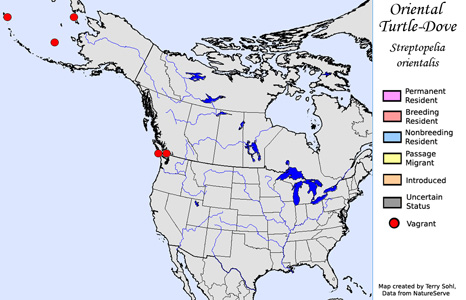| Length: 13 inches | Wingspan: 20-22 inches | Seasonality: Non-resident in South Dakota |
| ID Keys: Gray overall, rusty back and wing coverts with black feather centers, black and white stripes on side of nape | ||
 The
Oriental Turtle-Dove, also sometimes called the Rufous Turtle-Dove, is a
species normally found in Siberia and other parts of Eastern Asia. In
North America, they are extremely rare vagrants. Multiple sightings have
occurred in the western Aleutian Islands and on islands in the Bering Sea
west of the Alaska coast. These are almost certainly true vagrants,
wild birds that have naturally reached these areas from breeding locations
in eastern Asia. Multiple sightings have also occurred on Vancouver
Island in far southwestern Canada. The origin of these birds may be in
question, and may represent escaped cage birds. However, given the
migratory nature of the Oriental Turtle-Dove and its tendency to sometimes
wander far from its normal range, the Vancouver sightings may also represent
naturally occurring, vagrant birds.
The
Oriental Turtle-Dove, also sometimes called the Rufous Turtle-Dove, is a
species normally found in Siberia and other parts of Eastern Asia. In
North America, they are extremely rare vagrants. Multiple sightings have
occurred in the western Aleutian Islands and on islands in the Bering Sea
west of the Alaska coast. These are almost certainly true vagrants,
wild birds that have naturally reached these areas from breeding locations
in eastern Asia. Multiple sightings have also occurred on Vancouver
Island in far southwestern Canada. The origin of these birds may be in
question, and may represent escaped cage birds. However, given the
migratory nature of the Oriental Turtle-Dove and its tendency to sometimes
wander far from its normal range, the Vancouver sightings may also represent
naturally occurring, vagrant birds.
Habitat: Found in a very wide variety of habitats, particularly during migration and in the winter months. During the summer breeding season, they are primarily found in forested areas. These same habitats may be used in migration and in winter as well, but they are also often found in open habitats, particularly agricultural environments with available seeds and grains. They are also very well adapted to a human presence and are often found in urban and suburban settings.
Diet: Feeds heavily on seeds and grains. They have a bit of a reputation as a species that will negatively impact agricultural fields, especially rice and wheat, but also soybeans and other crops. They will also feed on herbs and forbs, and fresh young shoots of some plants.
Behavior: Forages on the ground, walking around and picking up seeds and other food items from the surface of the ground.
Nesting: The nest of a Oriental Turtle-Dove is a platform of sticks, lined with leaves and grasses, and placed in a tree or shrub. The female lays 2 eggs. The male usually incubates the eggs during the day, while the female incubates them in the evening and at night. The eggs hatch after about 2 weeks, and both parents help to feed and protect them. The young fledge from the nest after 15-18 days. Multiple broods are often raised each breeding season.
Song: Oriental Turtle-Doves are often quite vocal, issuing very frequent low cooing sounds.
Migration: In its native eastern Asia, southern populations may be year-round residents. However, those found in the northern part of its range are strongly migratory and move southward for the winter.
Interactive eBird map: Click here to access an interactive eBird map of Oriental Turtle-Dove sightings
Similar Species: They are similar in overall structure and size to several other dove and pigeon species, but the unique plumage makes them unlikely to be confused with any other species (if seen well) other than their close relative that European Turtle Dove. Both of these Turtle-Dove species are extremely rare visitors to North America. However, the Oriental Turtle-Dove has only been seen on the far western edge of North America. The European Turtle-Dove has only been seen on the far eastern edge of North America. Given the native range of these two species and past sightings in North America, the location of a sighting is thus a reliable method of distinguishing which of the two species a rare North American sighting may be. In terms of appearance, the European Turtle-dove is noticeably smaller, and tends to have a pinker blush on the breast.
Conservation Status: Oriental Turtle-Doves are found across a very broad geographic area, are common in parts of their range, and overall populations are considered stable. The IUCN thus lists the Oriental Turtle-Dove as a species of "Least Concern".
Further Information: 1) WhatBird - Oriental Turtle-Dove
2) Arkive.org - Oriental Turtle-Dove
3) BirdLife International - Oriental Turtle-Dove
Photo Information: Photo by Frankie Chu - licensed under Creative Commons Attribution NoDerivs 2.0 Generic License
| Click below for a higher-resolution map |
 |
| South Dakota Status: Non-resident in South Dakota |
Additional Oriental Turtle-Dove Photos (coming soon!!)
